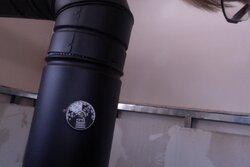What Continuous Operating Temperature Can the Double Wall Black Stovepipe Withstand
- #1
I'm getting used to a Drolet Eldorado EPA, non-cat stove. About 3 days of ~14hr long fires so far. Burning dry oak, split into 3-5" diameter pieces.
Double-wall stovepipe is about 3' vertical, then 3' horizontal to the Selkirk double-wall chimney.
So far, I haven't seen a stovepipe temperature above ~450F, and typical stovepipe temperature is about 300F. Measurement is taken with an SBI thermometer, which is a probe-type that sticks into the middle of the stovepipe. I installed the thermometer about 24" above the stove, and the above-stove damper has only ever been wide open.
So, is this an ok stovepipe temperature? Is there something else I should be doing (or burning) to get the temp higher?

Last edited by a moderator:
- #2
Seems high for the probe install, is that where they call for not to be put?
Those terms are low. I have a non cat stove 2 cubic foot box, double wall pipe is routinely cruising around 500-600 with a probe.
Probably either installed too high up or a bad thermometer. I have trouble seeing how the pipe could consistently stay so low.
- #3
My Drolet 2.2 CF non cat EPA rated stove will run between 400-700 depending on how dry the wood is, how much wood is being burned and the primary air setting. I run it at 700ish if I'm warming up the house after it has cooled down to 57 or 58 and around 450-500 degrees if it's close to my comfort range in the home.My probed gauge instructions said to mount it at 18" above the stove top. And I clean the probe every once in awhile for faster readings. I wouldn't have a damper installed in a modern stove if you have air control on the stove as even if it's open it will still restrict the smooth draft. Someone should jump in here to confirm this before you remove it though.
- #6
My temps on my Selkirk double wall stove pipe prove thermo read 500-600 usually when cruising. Once in a while gets up to around 900.......
- #8
Rumbling chimney usually isn't good....
My stove top right now is 340, probe is reading 600 inside the pipe.
Check your owners manual, should tell you where to measure your stove top temp and what it should be. Usually in the 300-550 range.
Little rain shouldn't hurt the wood too much.
On a fresh (cold ) start, I will crack the door depending on atmospheric conditions, until I get the flu into the "good zone to establish a strong draft.
Thinking you have a bum thermometer. I just checked my stove top with an IR thermometer and it appears to be 50-100 degrees off depending on how hot it is.
![]()
- #9
I wouldn't worry too much about 18" vs 24 ". Describe the chimney system that this stove is tied into. And describe this rumble in more detail.
Last edited:
- #13
Yes, chimney rumbling is not something you want.
If your probe is not defective, you are not getting your stove hot enough if you are not getting higher flue temps than that on start up, and you certainly don't need a flue damper. Sometimes a flue damper IS needed
I just loaded the stove about ten minutes ago, opened flue damper, bypass an stove air all the way. Three minutes probe thermometer at 450, closed flue damper all the way (which closes flue 80%), reduced air feed to half way; at 10 minutes probe thermometer 800 degrees and very active fire. Closed air to barely open, closed bypass, now two minutes later, secondaries and 600 degree probe temp. That temp will go down gradually now throughout the burn.
I'd be worried about creosote formation further up the pipe with those low temps being your maximum temps.
Can you tell us what your burning technique is and whether you are getting any secondary burn?
mccaffreytheartumety1964.blogspot.com
Source: https://www.hearth.com/talk/threads/double-wall-stovepipe-temp.137970/

0 Response to "What Continuous Operating Temperature Can the Double Wall Black Stovepipe Withstand"
Post a Comment